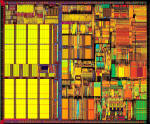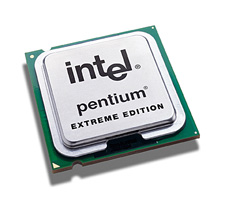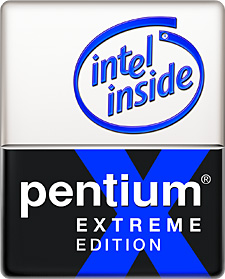Thursday, February 19, 2009
20 post- 2003: Intel® Pentium® M Processor
The Intel® Pentium® M processor, the Intel® 855 chipset family, and the Intel® PRO/Wireless 2100 network connection are the three components of Intel® Centrino™ mobile technology. Intel Centrino mobile technology is designed specifically for portable computing, with built-in wireless LAN capability and breakthrough mobile performance. It enables extended battery life and thinner, lighter mobile computers.
19 post- 2002: Intel® Itanium™ 2 Processor
The Itanium™ 2 processor is the second member of the Itanium processor family, a line of enterprise-class processors. The family brings outstanding performance and the volume economics of the Intel® Architecture to the most data-intensive, business-critical and technical computing applications. It provides leading performance for databases, computer-aided engineering, secure online transactions, and more.
18 post- 2001: Intel® Itanium™ Processor
The Itanium™ processor is the first in a family of 64-bit products from Intel. Designed for high-end, enterprise-class servers and workstations, the processor was built from the ground up with an entirely new architecture based on Intel's Explicitly Parallel Instruction Computing (EPIC) design technology. The processor delivers world-class performance for the most demanding enterprise and high-performance computing applications, including e-Commerce security transactions, large databases, mechanical computer-aided engineering, and sophisticated scientific and engineering computing.
18 post - 2001: Intel® Xeon™ Processor
The Intel® Xeon™ processor is targeted for high-performance and mid-range, dual-processor workstations, dual and multi-processor server configurations coming in the future. The platform offers customers a choice of operating systems and applications, along with high performance at affordable prices. Intel Xeon processor-based workstations are expected to achieve performance increases between 30 and 90 percent over systems featuring Intel® Pentium® III Xeon™ processors depending on applications and configurations. The processor is based on the Intel NetBurst™ architecture, which is designed to deliver the processing power needed for video and audio applications, advanced Internet technologies, and complex 3-D graphics.
17 post -Image Processor with JPEG Encoder
Nethra Imaging has announced its second generation smart camera chips, now available in the industry’s smallest package for low power, handheld consumer devices. The NI-2065/66 programmable image processor family can be integrated into camera module designs and handsets, providing consumers with “print quality” images from less expensive optics and digital still camera functionality from their mobile phone devices. The Image Processor is currently in production and includes a JPEG encoder for enhanced compression capabilities leading to high frame rate capture, hence reducing blur and storage time. Built on 0.13-micron and boasting low power, the image processors fit into a 5mm x 6mm package.

Image Processor
This allows camera module designers to achieve form factors as small as 8.5mm x 8.5mm, making them optimal for the smallest consumer devices. Use of the NI-2065/66 allows OEMs to develop smart camera modules faster than with alternative solutions, expediting time-to-market. Sophisticated true-color processing allows picture calibrating/ tuning to meet regional taste, while support for multiple sensors helps simplify the OEM's supply chain. “Small form factor and low power are key requirements for handheld devices,” said Tony Henning, editor of the Mobile Imaging Report from Future Image, “But with those constraints, delivering the print quality images and digital camera-like features consumers demand presents a challenge. Nethra’s second-generation image processors meet that challenge.”
16 post- Laptop Processors
- Runs at a lower voltage and clock speed -- This reduces heat output and power consumption but slows the processor down. Most laptops also run at a higher voltage and clock speed when plugged in, and at lower settings when using the battery.
- Mounts to the motherboard without using pins -- Pins and sockets take up a lot of room in desktop PCs. Some motherboard processors mount directly to the motherboard without the use of a socket. Others use a Micro-FCBGA (Flip Chip Ball Grid Array), which uses balls instead of pins. These designs save space, but in some cases mean that the processor cannot be removed from the motherboard for replacement or upgrading.
- Has a sleep or slow-down mode -- The computer and the operating system work together to reduce the CPU speed when the computer is not in use or when the processor does not need to run as quickly. The Apple G4 processor also prioritizes data to minimize battery drain.

An IBM ThinkPad’s processor
15 post-Smarter memory.
The Mac Pro incorporates a 256-bit-wide, fully buffered memory architecture with Error Correction Code (ECC), which corrects single-bit errors and detects multiple-bit errors automatically. These features are especially important in mission-critical or compute-intensive environments. Apple designed a more stringent thermal specification for the Mac Pro FB-DIMMs, so the internal fans spin at slower speeds and keep the system quiet.
14 post-More power with less power.
Inside the new Mac Pro is the latest technology from Intel: Quad-Core Intel Xeon “Harpertown” processors. These processors run at blazingly fast speeds up to 3.2GHz. Based on the new 45-nm Intel Core microarchitecture, they deliver amazing performance but still maintain outstanding energy efficiency.

13 post- Processer Photo
12 post- TWO ENGINES UNDER ONE HOOD
Think of a computer chip’s core--the central processing unitor CPU--as an engine.
See animation video [mpeg, 272 MB]
 In a single core processor, this “performance engine” takes in raw data and turns it into either video, movies, music, digital-photos, games, email, or other rich mulitmedia content. |  In a dual-core computer chip, there are two “performance engines” that can take more data and simultaneously process the data into rich multimedia content at a faster rate. |
11 post - 2000: Intel® Pentium® 4 Processor

Users of Intel® Pentium® 4 processor-based PCs can create professional-quality movies; deliver TV-like video via the Internet; communicate with real-time video and voice; render 3D graphics in real time; quickly encode music for MP3 players; and simultaneously run several multimedia applications while connected to the Internet. The processor debuted with 42 million transistors and circuit lines of 0.18 microns. Intel's first microprocessor, the 4004, ran at 108 kilohertz (108,000 hertz), compared to the Intel® Pentium® 4 processor's initial speed of 1.5 gigahertz (1.5 billion hertz). If automobile speed had increased similarly over the same period, you could now drive from San Francisco to New York in about 13 seconds.
10 post-1999: Intel® Pentium® III Xeon™ Processor
9 post-1999: Intel® Pentium® III Processor

The Intel® Pentium® III processor features 70 new instructions--Internet Streaming SIMD extensions-- that dramatically enhance the performance of advanced imaging, 3-D, streaming audio, video and speech recognition applications. It was designed to significantly enhance Internet experiences, allowing users to do such things as browse through realistic online museums and stores and download high-quality video. The processor incorporates 9.5 million transistors, and was introduced using 0.25-micron technology.
8 post-1999: Intel® Celeron® Processor

Continuing Intel's strategy of developing processors for specific market segments, the Intel® Celeron® processor is designed for the value PC market segment. It provides consumers great performance at an exceptional price, and it delivers excellent performance for uses such as gaming and educational software.
7 post-1998: Intel® Pentium II Xeon Processor
The Intel® Pentium II Xeon processors are designed to meet the performance requirements of mid-range and higher servers and workstations. Consistent with Intel's strategy to deliver unique processor products targeted for specific markets segments, the Intel® Pentium II Xeon processors feature technical innovations specifically designed for workstations and servers that utilize demanding business applications such as Internet services, corporate data warehousing, digital content creation, and electronic and mechanical design automation. Systems based on the processor can be configured to scale to four or eight processors and beyond.
6 post-1997: Intel® Pentium® II Processor
The 7.5 million-transistor Intel® Pentium II processor incorporates Intel® MMX™ technology, which is designed specifically to process video, audio and graphics data efficiently. It was introduced in innovative Single Edge Contact (S.E.C) Cartridge that also incorporated a high-speed cache memory chip. With this chip, PC users can capture, edit and share digital photos with friends and family via the Internet; edit and add text, music or between-scene transitions to home movies; and, with a video phone, send video over standard phone lines and the Internet.
5 post- 1995: Intel® Pentium® Pro Processor
Released in the fall of 1995 the Intel® Pentium® Pro processor is designed to fuel 32-bit server and workstation applications, enabling fast computer-aided design, mechanical engineering and scientific computation. Each Intel® Pentium Pro processor is packaged together with a second speed-enhancing cache memory chip. The powerful Pentium® Pro processor boasts 5.5 million transistors.
4 post-1993: Intel® Pentium® Processor
3 post-1989: Intel486™ DX CPU Microprocessor
The Intel486™ processor generation really meant you go from a command-level computer into point-and-click computing. "I could have a color computer for the first time and do desktop publishing at a significant speed," recalls technology historian David K. Allison of the Smithsonian's National Museum of American History. The Intel486™ processor was the first to offer a built-in math coprocessor, which speeds up computing because it offloads complex math functions from the central processor.
2 post-1985: Intel386™ Microprocessor

The Intel386™ microprocessor featured 275,000 transistors--more than 100times as many as the original 4004. It was a 32-bit chip and was "multi tasking," meaning it could run multiple programs at the same time.
The Intel386™ microprocessor featured 275,000 transistors--more than 100times as many as the original 4004. It was a 32-bit chip and was "multi tasking," meaning it could run multiple programs at the same time.
1 posr->1971: 4004 Microprocessor
Monday, February 16, 2009
Processor Attachment
 |
The system can function with one or two processors installed. For a single-processor system, a processor bus terminator card must be installed in the unused processor socket. For a dual-processor system, both processors must be the same speed.
Processors
The system board contains two Intel SC242 (Slot 1) processor sockets. Each socket has an associated voltage regulator integrated on the system board.
Each processor socket accepts an Intel Pentium III processor (133 MHz front-side bus). The processor is secured to its socket by retention clips on both sides. The retention clips are secured by nuts to screws attached to the system board.
HP MediaSmart Server Processor Upgrade
The site Home Server Hacks have posted a tutorial on how to upgrade the processor in the HP MediaSmart Server EX470/475 from the supplied 1.8GHz Sempron, which is a Socket AM2 to a low power (45W) 2.6GHz processor with 1MB of L2 cache (from 256KB in the Sempron). And all for the bargain basement price of only $55.
Ibm Thinkpad T60p 2.33ghz 2g-

Specifications: Ibm thinkpad t60p 2.33ghz 2g-399 usd$(shipping free) General Model name:2613h5u Description: Thinkpad t60p Back to top Operating system Operating system provided: Microsoft windows xp professional Back to top Architecture Bus type/architecture: Pci/pci express Slots x bays total (available):4(3) x 1(1) Orientations allowed: Form factor: Notebook Back to top Processor Processor manufacturer: Intel Processor (cpu)2: Intel core processor duo t2700 Processor internal clock speed2:2.33ghz Front side bus:667mhz Back to top Memory Memory (ram) std/max:2gb/4gb Ram slots total:2 sodimm Ram slots available:0 sodimm Ram speed:667mhz Ram type: Pc2-5300 ddr2 sdram Back to top Hard disk Hard disk size1:100gb Hard disk type: Sata Back to top Graphics subsystem Graphics type: Uxga ips Graphics chip set: Ati mobility firegl v5200 Video ram type: Gddr3 Max resolution (with max video ram):2048x1536 16777216 colors Max colors (with max video ram):16777216 Graphics bus interface: Pci express Back to top Optical device Optical device/speed: Dvd-recordable Floppy diskette size: -- Back to top Audio Speakers:2 (internal speakers) Integrated speakers:2 Audio chipset: Intel high definition audio Back to top Communications Ethernet description: Integrated intel pro/1000 gigabit ethernet Ethernet interface type: Gigabit ethernet- integrated Ethernet speed:1000mbps,100mbps,10mbps Back to top Standard features Mouse: Thinkpad ultranav Keyboard type: Full size IBMSupply Ability: up to 10 units
[Related Categories: Notebooks/Laptops ]
Dell Inspiron 9400/E1705 T7400/2.16/

Specifications: Intel Core 2 Duo Processor T7400-399 usd(shipping free) Specs: 17 inch UltraSharp TrueLife Wide-screen WUXGA(best option) 2GB, DDR2,667MHz 2 Dimm(fastest option) 256MB NVIDIA GeForce Go 7900 GS(fastest option) 100GB 7200RPM SATA Hard Drive(fastest option) Integrated 10/100 Network Card and Modem 8X DVD+/-RW Drive SoundBlaster Advanced Audio for XPS M1710(best option) Intel PRO/Wireless 3945 802.11a/g Mini Card (54Mbps) Dell Wireless 355 Bluetooth Module (2.0 + EDR) 80 WHr 9-cell Lithium Ion Primary Battery(longest powering option) Microsoft Windows XP Professional Service Pack 2, English Dell Direct Download Free Promotion for 16 in. Skin DELL SUPPORT 3.0 Corel WordPerfect 12 plus Trial of Quartro Pro and Presentations AOL BSD/SMB NETZERO ISP PC Restore Recovery System by Symantec Quickbooks 2006 Special SimpleStart Windows Media Player 10 Internet Search and Portal CyberLink PowerDVD v5.7 Decoding Sofware for DVD Drives Adobe Acrobat Reader 6.0 And Your FREE Kensington Wireless MouseDellSupply Ability: 3
[Related Categories: Notebooks/Laptops ]
Dell XPS M1710 Intel Duo Core Proc 2.16 GHz

Specifications: Dell xps m1710 intel duo core proc 2.16 ghz--499 usd(shipping free) Xps m1710, intel core duo processor (2.16 ghz/667 fsb) system upgrade!!!!! 17 inch ultrasharp truelife wide screen wuxga with black lcd cover 2 gb shared dual channel ddr2 sdram 667 mhz,2 dimm 512 mb nvidia geforce go 7900 gtx system upgrade!!!! 100 gb 7200 rpm sata hard drive system upgrade!!!! Microsoft windows xp media center edition 2005 Windows media player 10 Dell owners manual installed on your system click on icon after system set up to access Dell resource cd with application backup with tools Dell support 3.0 Dell download direct Internet search and portal Image restore Intergrated10/100/1000 network card and modem Adobe acrobat reader 6.0 8x dvd+/- rw drive Roxio creator basic/mydvd basic Sonic cineplayer High definition audio system upgrade!!! Intel pro/wireless 3945 802.11 a/g mini card 54 mbps Dell wireless 355 bluetooth module (2.0+ edr) system upgrade!!!!!! Network associates mcafee 7.0 90 day trial 80 whr 9-cell lithium ion battery Aol bsd/smb Broadband icon Netzero isp Paint shop photo album 6.0 starter edition Corel wordperfect 12 plus trial of quarto pro and presentations Soft contracts - qualxserve 1 year warranty Next business day parts and labor on site response first year Windows vista capable Quickbooks 2006 special simple start editionDellSupply Ability: up to 10 units
[Related Categories: Notebooks/Laptops ]
PANASONIC Intel Pentium M 778 (1.6GHZ)

Specifications: Processor - intel pentium m processor ulv 778 (1.6 ghz),2mb l2 cache, 400mhz fsb. Memory - 512mb sdram (ddr2400) standard, expandable to 1024mb (pc2-3200 memory is required). Display - 14.1" 1400 x 1050 sxga anti-glare tft active matrix color Lcd. External video support up to 1600 x 1200 at 16,770,000 Colors. Intel 855gm integrated video controller max.64mb (uma) Vram. Drives - 60gb hdd Combo drive (dvd-rom/cd-rw) standard Audio - sigmatel stac9751 ac-97 v.2.3 compliant audio codec Integrated speaker Convenient keyboard volume controls Card slots - (1) 32-bit pc card type ii slot Accepts secure digital (sd) cards. Communications- intel pro/wireless 2915abg network connection 802.11a/b/g Security - authentication: Leap, wpa,802.1x, eap-tls, Eap-fast, peap Encryption: Ckip, tkip,128-bit and 64-bit wep, hardware Aes. Ports - (2) usb 2.0 ports (1) rj-45 lan port (1) 15-pin vga port (1) rj-11 modem port (1) microphone/line-in port (minijack) (1) headphones/speaker (minijack stereo) Keyboard - 87-key with dedicated windows key Touchpad - electrostatic touchpad with vertical scrolling support Software - includes microsoft windows xp professional Includes setup, diagnostics, on-line reference manual, Adobe reader. Security - password security: Supervisor, user, hard-disk lock Cable lock slot Accessories - cfwmbav0512 512mb memory card Power source - lithium ion battery pack (7.4v,7650mah) Battery operation: Up to 5 hours Battery charging time: Approximately 5 hours off,6.5 hours On. Ac adapter: Ac 100v-240v 50/60hz, auto sensing/switching Worldwide power supply. Pop-up on-screen battery status reporting PANASONICSupply Ability: up to 10 units
Ibm Thinkpad T60p 2.33ghz 2g-399 Usd$
Specifications: Ibm thinkpad t60p 2.33ghz 2g-399 usd$(shipping free) General Model name:2613h5u Description: Thinkpad t60p Back to top Operating system Operating system provided: Microsoft windows xp professional Back to top Architecture Bus type/architecture: Pci/pci express Slots x bays total (available):4(3) x 1(1) Orientations allowed: Form factor: Notebook Back to top Processor Processor manufacturer: Intel Processor (cpu)2: Intel core processor duo t2700 Processor internal clock speed2:2.33ghz Front side bus:667mhz Back to top Memory Memory (ram) std/max:2gb/4gb Ram slots total:2 sodimm Ram slots available:0 sodimm Ram speed:667mhz Ram type: Pc2-5300 ddr2 sdram Back to top Hard disk Hard disk size1:100gb Hard disk type: Sata Back to top Graphics subsystem Graphics type: Uxga ips Graphics chip set: Ati mobility firegl v5200 Video ram type: Gddr3 Max resolution (with max video ram):2048x1536 16777216 colors Max colors (with max video ram):16777216 Graphics bus interface: Pci express Back to top Optical device Optical device/speed: Dvd-recordable Floppy diskette size: -- Back to top Audio Speakers:2 (internal speakers) Integrated speakers:2 Audio chipset: Intel high definition audio Back to top Communications Ethernet description: Integrated intel pro/1000 gigabit ethernet Ethernet interface type: Gigabit ethernet- integrated Ethernet speed:1000mbps,100mbps,10mbps Back to top Standard features Mouse: Thinkpad ultranav Keyboard type: Full size IBMSupply Ability: up to 10 units
[Related Categories: Notebooks/Laptops ]
Processor Markings

Record the processor markings from the physical processor. The markings on the box label are not sufficient. The information you need is identified in example 2 and 3.
Figure 2 details the general markings used for most current Intel processors. Figure 3 shows the markings for older processors. The location of certain markings (for example, Processor #) vary based on the type of processor you have.







